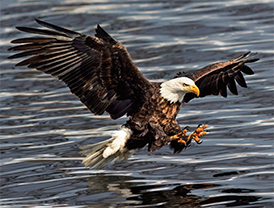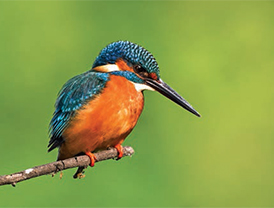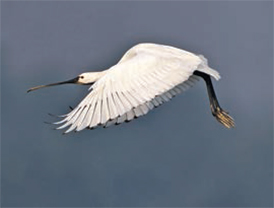6. Birds in Flight
Birds fly and that’s what set them apart. Isn’t it?
The most interesting part of bird photography is capturing their magnificent flight. This is a tricky aspect for beginners and pros alike. It is not easy to take flight photographs that will wow the viewers.
The success of birds-in-flight photography largely depends on the bird as well as the technique that one employs.
Smaller birds have erratic flight behaviors. It becomes quite difficult to track them since they are too small in the frame. Larger birds normally follow a pattern. You can guess what appens next. It becomes easier to track them.
If you want to be a successful birds-inflight photographer, you should start with the larger and slow moving birds. Learn all the field techniques to capture perfect photographs of these birds.
Once you are confident with the techniques, you can venture on to the smaller birds.
Here are some simple tips to capture birds-in-flight photographs:
• Learn about the birds’ flight patterns. • Know their landing and take-off patterns. • Spend enough time in the field observing them.
• Wait for some cues to anticipate the next action. For instance, many birds defecate before taking off, some birds run to gain momentum, etc.
• If there is more than one bird, it is almost always the case that if one flies the rest will follow.
• Track the bird for a while and let the camera achieve focus.
• Wait for the best background.
• Take the shots in a continuous burst.
• Use Aperture Priority or Shutter Priority mode to keep things simple.
• Go for ISO 400 so that you get reasonably fast shutter speeds and without any digital noise.
• Make sure to get the wings in upwards position as much as possible.
7. Background Makes the Picture
Do you really care for the background in your photographs?
If you said yes, you might want to check your gallery again. Because you might not have really checked it thoroughly.
Why does that happen? You might have photographed a gorgeous bird. But you see that the photograph is not appealing. Something is not right. The most likely reason is the distracting background.
Remember that the background is as important as the subject.
But, generally, you are so bogged down with your subject that you won’t see anything else. That’s natural!
The problem is that it doesn’t work.
Only when the background is clean and/or complementary, the bird has a chance to grab the viewer’s attention. The bird has to be complemented by its surroundings; the surroundings should not be distracting.
Below are few simple tips to get a clean background:
• Wait for the bird to assume a good position.
• Change your position to get an interesting background.
• Aim for shallow depth-of-field to throw the background out of focus.
Basically you have to avoid distracting backgrounds. If possible, also avoid plain and boring backgrounds like white sky. It makes for a boring photograph. The next time you make a bird photograph, don’t forget to check the background. This is the best bird photography tip you can follow.
Bonus Tip: Practice with Common Birds
It’s not about rare species, it’s about rare photographs!
Most often, bird photographers run behind rare species. They travel many miles to photograph a rare species. Why? Are you documenting the birds? Are you creating a portfolio of different bird species?
It’s not necessary. Think about it. Do you like a rare photo of a common bird? Or a common photo of a rare bird?
Practice with the common birds. Apply all the above techniques. Improve your photography first. Get to know their behavior. Understand how light impacts the mood of a photograph. Try new compositions.
Make Something Unique. |SP
Fully charged now?
Want to go out and practice? That’s great. That’s exactly what you should do. Practice, practice…and practice!
Focus your time and energy on learning all the core principles outlined above. Prove it to yourself that you have great passion to go out and photograph the birds every day or as often as you can.
Remember: Proper techniques will always outsmart the equipment.
Make every attempt to make amazing photographs of the common birds. Enjoy photographing birds. That is the secret to success.
Is there a park nearby? Is there a water body? A forest preserve, perhaps?
Whatever it is, just go there. Photograph birds. Take action. Unless you photograph you won’t improve.




